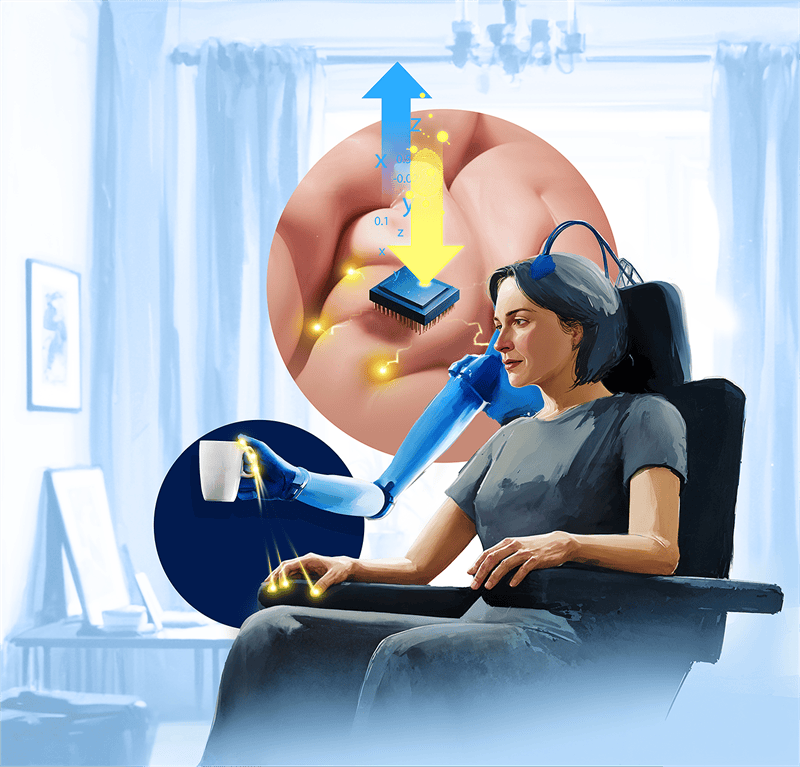Advanced neural interface enables sophisticated touch perception in bionic hand users
Advanced brain-computer interface technology has enabled individuals with spinal cord injuries to experience complex touch sensations whilst controlling an external bionic hand, marking a significant development in neural prosthetics research.

An illustration showing a paralyzed individual with a spinal cord injury, implanted with intracortical electrodes in the brain. This brain-computer interface (BCI) allows the individual to control a bionic limb that is not attached to the body, directly with thoughts, to reach and grasp a coffee mug. Due to embedded sensors, the bionic hand senses the grasped object as if it were being grasped with the human hand, communicating the touch sensations to the user’s brain via advanced neurostimulation.
© Chalmers University of Technology | Boid | David Ljungberg
Researchers from the Cortical Bionics Research Group have successfully developed a method to encode natural touch sensations through targeted microstimulation of the brain using implantable electrodes. The technique, detailed in a new study published in Science, enables individuals with spinal cord injuries to not only control a bionic arm through thought but also to experience sophisticated tactile sensations including edges, shapes, curvatures and movements.
Lead author Giacomo Valle, Assistant Professor at Chalmers University of Technology, emphasises the unprecedented nature of these achievements: “In this work, for the first time the research went beyond anything that has been done before in the field of brain-computer interfaces (BCI) – we conveyed tactile sensations related to orientation, curvature, motion and 3D shapes for a participant using a brain-controlled bionic limb. We are in another level of artificial touch now.”

Giacomo Valle, Chalmers University of Technology
Technical implementation
The study involved two participants who received chronic brain implants in both sensory and motor regions associated with arm and hand function. Over several years, researchers recorded and decoded the various patterns of electrical activity in the brain related to motor intention. The implanted technology allowed for direct brain control of an external bionic arm mounted on a wheelchair or similar equipment.
The breakthrough lies in the development of specific stimulation patterns that, when applied through the brain implants, create recognisable tactile sensations. When sensors on the bionic arm contact objects, the system transmits corresponding stimulation to the brain, creating sensations that feel localised to the hand.

Charles M. Greenspon, University of Chicago
Clinical significance and limitations
For individuals with spinal cord injuries, the loss of touch sensation significantly impacts their ability to manipulate objects effectively, even when using assistive devices. The incorporation of sensory feedback represents a crucial step toward improving the functionality and user acceptance of neural prosthetics.
The current research demonstrates the feasibility of complex touch sensation through brain stimulation, though several technical challenges remain. The researchers note that more sophisticated sensors and robotic technology, including prosthetic skin, would be necessary to fully capture and convey the complete range of touch sensations they can now encode.
Future directions
The study’s findings have attracted significant commercial interest, particularly in the United States, where several research institutions and private companies are working to commercialise implantable neurotechnology. Some components of the system used in this study are already under development by an American neurotech company.
The research team acknowledges that different regulatory environments, particularly in Europe, may affect the translation of these emerging neurotechnologies into clinical applications. The involvement of Chalmers University of Technology aims to establish a European hub for neurotech research through the Cortical Bionics Research Group.
The study represents an important step toward restoring natural touch sensation in individuals with spinal cord injuries, though the researchers emphasise that further development of both the implantable technology and external sensors will be necessary to expand the repertoire of available sensations.
Reference:
Valle, G., Alamri, A. H., Downey, J. E., et. al. (2024). Tactile edges and motion via patterned microstimulation of the human somatosensory cortex. Science. doi: https://doi.org/10.1126/science.adq5978

